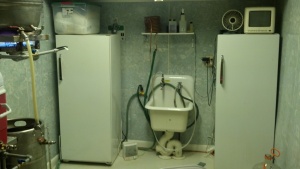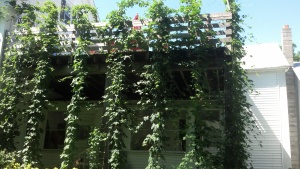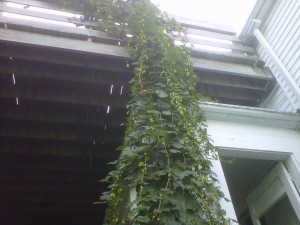Yes. It was Chuck who greeted me. His place is also his place of work—a funeral home. As a friend recently commented, “What better place to ferment lagers?” (For those of you who don’t know, lagers require refrigerator-like temperatures to ferment. But have no fear, the beer was removed from any type of formaldehyde or morgue.)
Beyond the funeral home, the first thing I noticed about Chuck’s homebrew was the set-up. He actually has a small room dedicated to the brewing and the set-up is way more elaborate and inventive than mine: boiling kettles fabricated out of old kegs and a cooler; a home-made framework designed to work with gravity; wing-wangs that rapidly chill the brew after it’s been boiling; a conical fermenting container for easy separation of sediment; a fridge for lager fermenting; another fridge to store bottled brews and yeast; a laptop specifically for beer recipes; and all materials required for kegging his brews. Here are some pictures of his brew room, or, as I like to call it, the Broom.
He also had a really cool device that electronically measures the sugar content of brew. It’s called a Brix refractometer. I’m still in awe of it. I use the good ol’ hydrometer instead which involves trying to read a measurement through a cloudy meniscus and then puzzling over its meaning. Since the Brix refractometer is pricey—a minimum of $75 in a quick Google search—I guess I will puzzle over the hydrometer some more. The link below actually does help clear things up a bit for me. Yea for the Internet!
http://distillers.tastylime.net/library/Fermentation-chart/fermentation-chart.htm
Chuck and I sampled many of his incredible home brews on this visit. These two are the ones that stood out the most to me.
- Chipotle Pepper Beer. Light in color. Smooth up front but in the end it kicks you in the uvula with a spicy-hot, smokey chiptole flair– and makes you want to drink more to quench the flame. I suspect drinking a great deal of this would have you singing “Burning Ring of Fire” on the toilet the next day. Me thinks I want the recipe! Hee, hee, hee!
- Candy Beer. Light in color. Smelling of Pixy Stix and tasting of Sweet Tarts. Think fruity drinks that don’t taste like alcohol—a beer for the stereotypical chick who claims she doesn’t like beer. Actual ingredients used to sweeten the batch were Sour Apple Jolly Ranchers and a few Grape flavored ones, too. If this beer were ever marketed it would go great with candy cigarettes.
Moving on…
I asked Chuck why he chooses to homebrew versus buying craft or micros at the store. Paraphrasing his answer, he likes to be as involved in the process as possible. Instead of brewing with extracts (a syrup looking much like molasses), he steeps the malted barley. Instead of purchasing new yeast every time, he propagates and re-pitches yeast for several brews. And instead of purchasing hop pellets like I do, he grows his own crop in his back yard!
I love that Chuck grows his own raw hops and he loves the challenge of creating beer from the purest ingredients he can find. But what of the ingredients in beer? If you didn’t know, by definition beer must contain the following four ingredients: water, yeast, malted barley, and hops. I guess most of you know what the first two ingredients are. Perhaps you’re fuzzy on the third and you’re wondering what the hell hops are.
Let’s start with Hops. These are the flowers that impart flavor and aroma to beer. They also help stabilize the beer and balance the sweetness of the malted barley. Here are some photos of Chuck’s hops.
And what of malted barley? We all know that barley is a grain, but why is it malted and what does that mean? Malting is a process that involves germination and then heating to halt germination of the barley seed. This process causes some of the starches of the barley seed to turn into sugars. When eventually added to the brew, the yeast eats the sugars from the malted barley creating byproducts that I like to refer to as farts (carbon dioxide) and urine (alcohol). Don’t be so freaked out—pieces of fruit are actually plant ovaries.
Okay, time to get back on course.
In closing I want to extend my most sincere thanks to Chuck for his willingness to share his knowledge, brews, and passion with me. I also thank our mutual acquaintance for introducing us—you know who you are and you’ve been a windfall for me and my budding blog. As the Irish say, “Tanks a million!”





